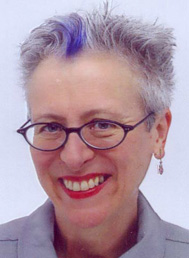Sally Kindberg is an illustrator and writer, who uses comic strip frames as ‘little theatres’ and is drawn towards dark humour and velvety black ink. She lives in London, has one daughter and many robots.

What inspires you?
Comics, journeys, bits of obscure information.
Did you always draw?
I started making notebooks when I was about 9, cut out bits from comics, drew stories, stuck in sweetie labels etc. I didn’t start reading till I was 8. My eyesight was very bad, and my mum didn’t want me to wear glasses, so she tried prayer which didn’t quite work. Luckily one of my teachers had a word with her, and National Health specs did the trick.
What did you read?
The first book was Grimm’s Fairy Tales – terrifying and wonderful. Reading seemed like magic to me, and still does.
What attracted you to drawing comics?
Early influences were Beano and Dandy – Desperate Dan’s creator Dudley D. Watkins was a marvellous illustrator.
I love the way you can give anyone or anything a voice by using speech bubbles, use the frames as little theatres full of surprises, and the way cropping and scale can be almost cinematic. Visual humour is most important too of course.
Who are your favourite comic book artists?
There are loads of them! Matt Groening, Yuichi Yokoyama, Marjane Satrapi, Art Spiegelman, Jochen Gerner, Roz Chast, and many more. And especially those with very dark humour like Mark Beyer.
I like pictures which are punchy black and white, there’s something exciting about velvety black ink.
Do comics get a bad press?
I think in the past they did – they weren’t taken seriously. Some writers I know kind of looked down on graphic novels/comic strips because they use pictures, which is crazy because some of them combine words and images in an incredibly powerful way, and it’s not always easy getting them to work together.
Graphic novels are viewed differently now, they get much more respect (I hope).
What was your lucky break?
During my second year at art college in the Midlands we were encouraged to get work experience, so I came to London and very nervously took a folder of illustrations round to a magazine called New Society.
I got my first commission, for a little black and white drawing which earned me £5 – it felt amazing. Then I worked for Honey Magazine.
What quality do you need as a freelance?
Getting work before I left college made me feel I might do anything – not strictly true of course – but you need to be pretty optimistic and determined to work as a freelance.
Ever been tempted to write?
Much later when I was drawing regularly for the Independent, illustrating travel features, possibly a bit cheekily I thought, why not write the features myself?
I worked as a freelance travel writer for various newspapers for a few years, and had some fascinating trips – including going to Elf School in Iceland, investigating horse-racing in Newmarket, and sailing on a Tall Ship to Lisbon.
What’s happening at the moment?
I’ve been collaborating with author Tracey Turner on a series of comic strip books for Bloomsbury which is great fun. I’m drawing pictures for the next one, which will be our third.
I’m also running comic strip workshops in libraries for children, developing other comic strip ideas and occasionally writing interview features.
Have you had rejections from publishers/agents?
Yes, of course! If they make constructive criticisms then I respect them, if not then I think, how dare they, it’s their loss etc… and wipe the tears off my glasses.
And you have an agent now…
A Paris-based agent has just started to represent my drawings in France. It’s very exciting, we’ll have to see what happens.
Do you have a working routine?
Yes, definitely. I had to bring up my daughter on my own so work fitted in around her nursery or school day, and I still work mostly round those times (though my daughter’s a big grown-up person now).
Mornings are best for work. And I have a lucky pen (I’m a pen and ink person) made of faded red wood and metal held together with tape.
Your tips for those just starting out?
Being curious about stuff, and optimistic about work is pretty important, especially when times are hard.
Lucky pens/brushes/computers may be handy too!
Comments